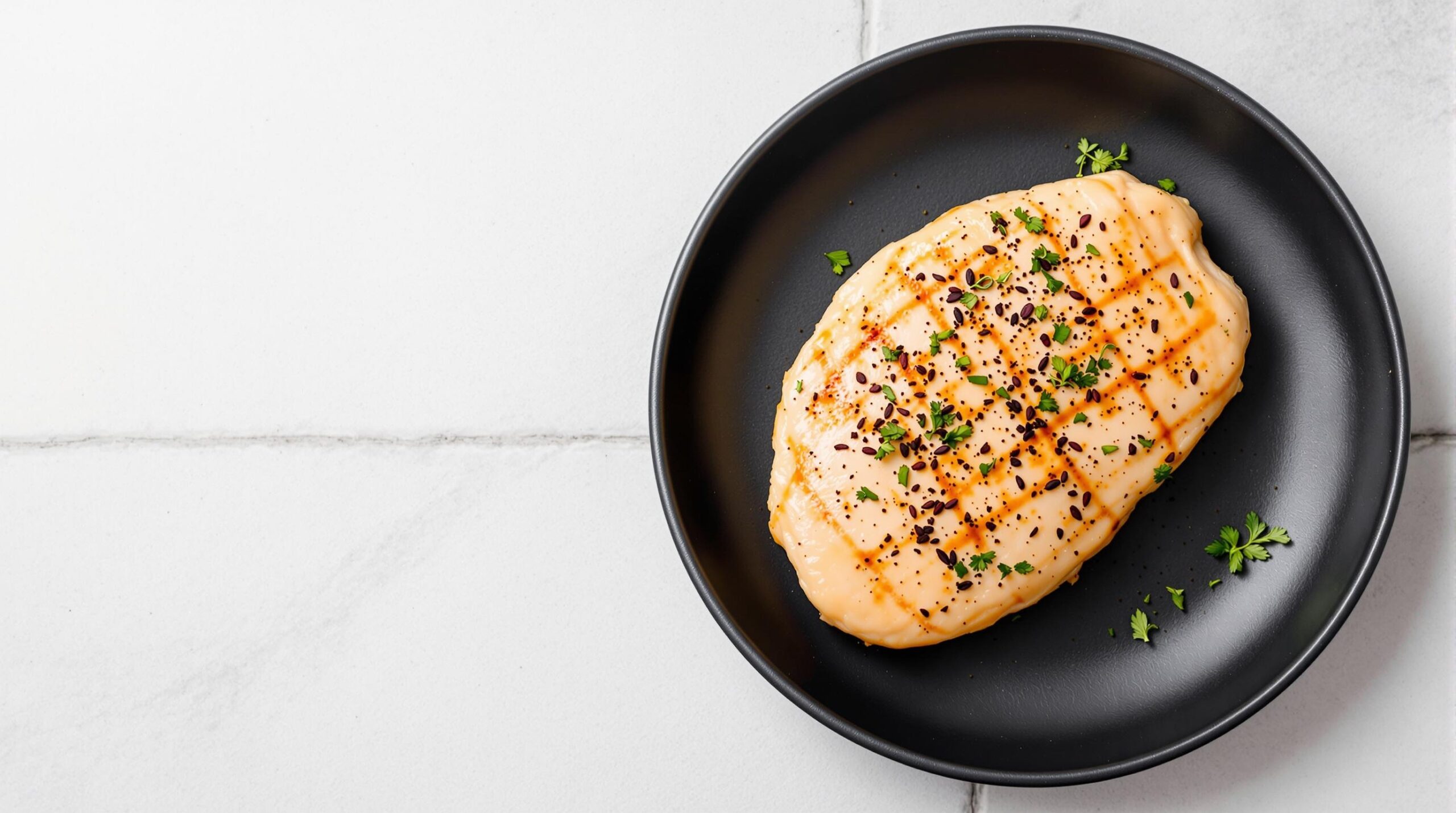Chicken breast is a staple in fitness nutrition, offering an exceptional protein-to-calorie ratio that makes it ideal for muscle development and recovery. A 4 oz serving of chicken breast delivers approximately 26 grams of high-quality protein with minimal fat, making it one of the most efficient protein sources for athletes and fitness enthusiasts looking to improve their body composition.
Key Takeaways
- A 4 oz chicken breast provides about 26 grams of complete protein with only 110-140 calories
- Chicken breast contains all nine essential amino acids needed for muscle repair and growth
- The low fat content (1-3g per 4 oz) makes it an ideal protein source for those managing body fat
- Chicken breast provides important B vitamins and minerals that support energy production and recovery
- Consistent protein intake from sources like chicken can enhance workout performance and accelerate results
Chicken Breast 4 oz Nutrition Breakdown
Understanding the complete nutritional profile of chicken breast helps explain why it’s such a valued food among fitness professionals. A standard 4 oz (113g) serving of boneless, skinless chicken breast typically contains:
- Calories: 110-140
- Protein: 24-26g
- Fat: 1-3g
- Carbohydrates: 0g
- Sodium: 70-80mg
- Potassium: 220-250mg
- Vitamin B6: 25% of Daily Value
- Niacin (B3): 60% of Daily Value
- Phosphorus: 15% of Daily Value
The protein density of chicken breast 4 oz nutrition makes it particularly valuable for athletes. When you’re trying to hit high protein targets without excessive calories, few foods can match its efficiency.

Why Chicken Breast Protein Quality Matters
Not all protein sources are created equal. Chicken breast contains a complete amino acid profile, including all nine essential amino acids that your body can’t produce on its own. This makes it a superior protein source compared to many plant-based options.
The amino acid leucine, which is abundant in chicken breast, is particularly important as it directly triggers muscle protein synthesis. This critical process repairs and builds muscle tissue after exercise. A 4 oz serving of chicken breast contains approximately 2g of leucine—well above the threshold needed to stimulate muscle growth.
Many elite athletes like those who train like CrossFit champions rely on chicken breast as a dietary staple precisely because of this optimal amino acid composition.
How Chicken Breast Fuels Muscle Recovery
The protein in chicken breast plays a crucial role in post-workout recovery. When you exercise, especially during resistance training, you create microscopic tears in muscle fibers. Protein provides the building blocks (amino acids) needed to repair this damage and build stronger, larger muscles.
For optimal recovery, timing your protein intake matters. Consuming chicken breast within 1-2 hours after your workout can help maximize the anabolic window—the period when your muscles are most receptive to nutrients for repair and growth.
Here’s how chicken breast supports the recovery process:
- Provides raw materials (amino acids) for tissue repair
- Stimulates protein synthesis to build new muscle
- Helps reduce muscle breakdown (catabolism)
- Supports immune function during recovery
Chicken Breast vs. Other Protein Sources
While chicken breast 4 oz nutrition is impressive, how does it stack up against other common protein sources? Here’s a quick comparison of 4 oz servings:
- Chicken Breast: 26g protein, 1-3g fat, 0g carbs, 110-140 calories
- Salmon: 22g protein, 9g fat, 0g carbs, 180 calories
- Lean Beef: 22g protein, 5g fat, 0g carbs, 130-150 calories
- Tofu: 10g protein, 6g fat, 2g carbs, 100 calories
- Greek Yogurt: 10g protein, 0-5g fat, 5g carbs, 80-130 calories
The protein-to-calorie ratio of chicken breast is hard to beat, making it particularly valuable for those monitoring their caloric intake while maximizing protein consumption. This advantage is one reason many world record lift holders include it as a cornerstone of their nutrition strategy.
Integrating Chicken Breast Into Your Fitness Nutrition Plan
Incorporating chicken breast into your diet doesn’t have to be boring. Here are practical ways to include this protein powerhouse in your nutrition plan:
- Meal prep: Cook multiple chicken breasts at once for easy grab-and-go protein throughout the week
- Pair with complex carbs post-workout (sweet potatoes, brown rice, quinoa)
- Add to salads for a protein boost without excessive calories
- Use in stir-fries with plenty of vegetables for micronutrients
- Create protein-packed wraps or sandwiches for portable nutrition
For optimal results, aim to distribute your protein intake throughout the day rather than consuming it all at once. Research suggests that 20-30g of protein per meal (roughly the amount in 3-4 oz of chicken breast) maximizes muscle protein synthesis.
Chicken Breast and Performance Enhancement
Beyond muscle building, the protein from chicken breast supports overall athletic performance in several ways. The B vitamins abundant in chicken breast—particularly niacin, B6, and B12—play essential roles in energy metabolism, helping your body convert food into fuel more efficiently.
Athletes focused on achieving peak performance, like those pursuing chest press world records, often pay careful attention to both their protein intake and these supporting micronutrients.
The selenium and phosphorus in chicken breast also support cellular energy production and thyroid function—both critical for maintaining energy levels during intense training sessions.
Timing Your Chicken Breast Consumption
When you eat your chicken breast can be almost as important as eating it at all. Here are strategic times to incorporate chicken breast for maximum benefit:
- Pre-workout (2-3 hours before): Provides sustained energy without digestive discomfort
- Post-workout (within 1-2 hours): Supports immediate recovery and muscle repair
- Before bed: The slow-digesting protein helps prevent muscle breakdown during sleep
- Between meals: Helps maintain consistent blood amino acid levels
For those training multiple times per day, strategic protein timing becomes even more crucial. Chicken breast’s digestibility makes it suitable for consumption relatively close to training sessions compared to fattier protein sources.
Practical Tips for Preparation and Storage
Making chicken breast a convenient part of your nutrition plan requires some preparation know-how. Here are tips for maximizing convenience without sacrificing nutrition:
- Cook chicken in batches using simple, versatile seasonings
- Slice or dice cooked chicken for easy portioning
- Store in portioned containers (4 oz servings) for grab-and-go protein
- Refrigerate cooked chicken for 3-4 days or freeze for up to 3 months
- Use a food scale initially to learn what 4 oz looks like (approximately the size of a deck of cards)
By preparing chicken breast in advance, you remove the decision fatigue that often leads to poor nutritional choices, especially when tired after a workout or busy day.
Conclusion
Chicken breast 4 oz nutrition offers an exceptional balance of high-quality protein with minimal fat and calories, making it an ideal choice for anyone serious about fitness and performance. The complete amino acid profile, particularly its leucine content, directly supports muscle development and recovery in ways few other foods can match so efficiently.
Whether you’re looking to build muscle, improve recovery, enhance performance, or simply maintain a lean physique, chicken breast deserves its reputation as a fitness nutrition staple. By understanding its nutritional profile and implementing the practical strategies outlined here, you can maximize the benefits of this protein powerhouse in your own training regimen.



